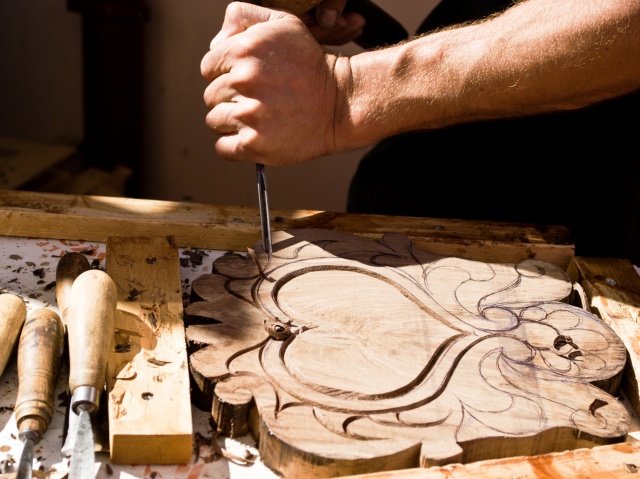Chip Carving
Contents |
Introduction
This form of wood carving involves the use of knives and chisels to remove small chips from the surface of a piece of wood. It can be used to decorate existing objects, easily drawing intricate designs with limitless possibilities.
It is advisable to use hard and high-quality wood for chip carving, as designs tend to look better in such materials. For experts, oak is the classic and traditional wood for carving. Beginners, however, are advised to work with wood that contains softer grain, such as lime, as it is easier to work with.
It is advisable to make cuts along the grain of the piece of wood to ensure fibres don’t tear at the cut line. A depth of 1/8” is the recommended maximum for the chipping cuts, and the chips should be carefully removed so they do not damage the wood. Cutting away from the previous chip ensures smooth removal.
Choosing a knife
A knife with a thin, wedge shape will allow for precise cuts.
For beginners, one knife will allow the creation of simpler designs. This knife should have a cutting edge as parallel to the handle as possible, as this will be easier to use.
Other knives may have a cutting edge in a rectangular shape, ideal for stabbing, and knives with a fine point that permit delicate woodwork. A knife with a round cross-section can be manipulated more easily, allowing the creation of more natural lines.
Gripping the knife
Gripping the knife correctly is vital if the cuts are to be made correctly and the design faultless. The back of the knife should be gripped with the fingers, and the thumb placed on a flat side that can be found on the front of the handle, under the blade. Keeping the thumb on the hand is crucial to preventing injury.
Another grip involves placing fingers on the front of the handle and the thumb on the back of the blade.
Both grips require that cutting is done at a 65° angle.
Pattern transfer
Creating intricate designs can be achieved by transferring patterns to a piece of wood of approximately 3/4” and 3/8” thickness. It is necessary to sand down the surface that is receiving the transference, as sanding dulls the designs after the carving process.
Graphite paper can be used to transfer designs to oddly shaped woods or, if preferred, a photocopy of a design can be placed against the wood. With an iron at medium temperature, the design is easily transferred as printer ink is heat sensitive.
Three corner chip technique
The wood should be placed either on the lap or on a table if is too big to be handled.
The first step is to use a plunge cut, involving a piercing motion into the wood at a 65° angle. Starting from where the plunge cut was made, a slicing cut should then be performed. Starting at a shallow depth, it should deepen until it reaches the depth of the plunge cut. The last step is to perform another slicing cut similar to the first one, in order to create a triangle. The piece of wood should pop out easily.
--G&S Specialist Timber 10:12, 06 Dec 2016 (BST)
Find out more
Related articles on Designing Buildings Wiki
Featured articles and news
RTPI leader to become new CIOB Chief Executive Officer
Dr Victoria Hills MRTPI, FICE to take over after Caroline Gumble’s departure.
Social and affordable housing, a long term plan for delivery
The “Delivering a Decade of Renewal for Social and Affordable Housing” strategy sets out future path.
A change to adoptive architecture
Effects of global weather warming on architectural detailing, material choice and human interaction.
The proposed publicly owned and backed subsidiary of Homes England, to facilitate new homes.
How big is the problem and what can we do to mitigate the effects?
Overheating guidance and tools for building designers
A number of cool guides to help with the heat.
The UK's Modern Industrial Strategy: A 10 year plan
Previous consultation criticism, current key elements and general support with some persisting reservations.
Building Safety Regulator reforms
New roles, new staff and a new fast track service pave the way for a single construction regulator.
Architectural Technologist CPDs and Communications
CIAT CPD… and how you can do it!
Cooling centres and cool spaces
Managing extreme heat in cities by directing the public to places for heat stress relief and water sources.
Winter gardens: A brief history and warm variations
Extending the season with glass in different forms and terms.
Restoring Great Yarmouth's Winter Gardens
Transforming one of the least sustainable constructions imaginable.
Construction Skills Mission Board launch sector drive
Newly formed government and industry collaboration set strategy for recruiting an additional 100,000 construction workers a year.
New Architects Code comes into effect in September 2025
ARB Architects Code of Conduct and Practice available with ongoing consultation regarding guidance.
Welsh Skills Body (Medr) launches ambitious plan
The new skills body brings together funding and regulation of tertiary education and research for the devolved nation.
Paul Gandy FCIOB announced as next CIOB President
Former Tilbury Douglas CEO takes helm.
UK Infrastructure: A 10 Year Strategy. In brief with reactions
With the National Infrastructure and Service Transformation Authority (NISTA).























